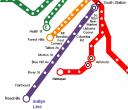The charm quickly peels awayfrom Boston's atavistic transit system. Like the crappy Pennsylvania Turnpike, we have the hemisphere's oldest subway. It seems like it.
Series note: This is part of the Rail-Volution inspired post set.
At the weekend's conference, I was surprised and pleased to learn about the Fairmount Corridor from two key players. Marvin Martin, who drove this city-train revolution as executive director of the Greater Four Corners Action! Coalition (no website) and Gail Latimore, who heads the Codman Square Neighborhood Development Corp., spoke.
I had sort of paid attention, but not enough, to the news over the years. This has been percolating for nearly two decades and is happening as we speak. I'll post details in a few days. However, the key concept it that Martin led largely African-American Bostonians between lower Hyde Park and South Station in indignation. A perfectly good commuter-rail line zipped through their neighborhoods, making the trip in 8 minutes. Read carefully to be fully aware that it made two stops on the way (Morton Street and Uphams Corner). In fact, there were no other stations for it to stop at over 8 miles, by design, where most people lived.
The bus or bus/subway alternatives for this large swath inhabited largely by lower-middle, poor and middle class residents of color was different. It took an optimum 45 minutes and more likely 60 to 90 for the same trip from where people live to where they work. There are four stations (New
Market/ South Bay, Columbia Road, Four Corners, Talbot Avenue, and Cummins Highway) \in the works in an activists' effort that started in 1987 and has continued relentlessly.
 I must be a typical American. I paid attention when it meant something personal. Moving to Fairmount Hill in Hyde Park after 21 years in Jamaica Plain, I was pleased to hear from the previous owners here that the Fairmount line at the bottom had a commuter rail. In a pig's eye it does.
I must be a typical American. I paid attention when it meant something personal. Moving to Fairmount Hill in Hyde Park after 21 years in Jamaica Plain, I was pleased to hear from the previous owners here that the Fairmount line at the bottom had a commuter rail. In a pig's eye it does.
Until the Indigo line is complete and the MBTA keeps its promise to increase trips, it is still a white commuters' line. Specifically, inbound, four trains are scheduled for Fairmount between 6:38 and 8:28 a.m. Likewise, outbound, there are four from South Station from 5:10 to 6:30.
Throughout the day, a few may stop if the conductor notices anyone flagging the train from the platform. The last possible train from South Station leaves at 9:30 p.m. and will stop to discharge only if passengers ask the conductor and that conductor remembers to tell the driver.
Weekends? Forget about it!
Moreover, this in unlike a real city transit system for pricing. With a Charlie Card fair of $1.70 for subway and $1.50 for bus, the irregular and inconvenient Fairmount is $4.25 each way, with no provision for transfers, even to buses.
I figure to go to Mike Capuano's function Monday at the Park Plaza from 6:30 to 8:30 p.m. That should be a good time to see how to get from here to there and perhaps even back.
First, note that the MBTA trip planner truly stinks. On Universal Hub and numerous blogs, they have depressing examples of being routed absurd ways to go short distances. In this case, I also found the T doesn't use fuzzy logic and requires silly specifics to find the most basic locations. For example, it can't find Back Bay Station without its ZIP code added, and it knows Milton Ave., but not Milton Avenue, but again only with a ZIP and not just the neighborhood. Lame.
For giggles, I asked about getting to and from the event. By the bye, the number 24 bus through Mattapan Square and up to Ashmont stops a half block from my house. The T doesn't seem to know that.
The T would have me spend $5.95 each way, with trip times from 63 to 97 minutes. Those using the commuter rail also indicate a flag stop for the train, which I don't trust from previous experience seeing trains pass vigorously waving potential passengers.
I know from a son who commutes to Latin Academy that a shank's mare version is quicker. A 10 or so minute walk to Cleary Square get a 32 bus in a minute or five, for $1.50. I gets to Forest Hills in 15 to 20 minutes. Then the Orange Line thumps to Back Bay Station in a similar time, for $1.70. So, for $3.20 and under an hour, I'd be done each way with a vastly more flexible schedule than any of the combinations the T suggests.
Were I still on crutches from my leg operation earlier this year, I'd do the 24 close by. I could take it from very close to Ashmont, then the Red Line subway to the Orange Line and get off by the hotel. That would be maybe 90 minutes, or T time.
In other words, it's expensive and slow, practically mandating a car trip with a pocket of quarters and driving around Back Bay for an open meter. That would be when people are leaving so it wouldn't take long.
That's not as significant as the many thousands who live between the Orange and Red Lines with no viable commuter rail. It is inconvenient and unnecessarily expensive.
I think of the much larger, longer, wide and more stop-filled NYC subways. In Manhattan alone, you can travel the 14 miles from the Battery North to Washington Heights local or express and get damned close to where you want fast. The city fare is $2.25 and trains go from where people live to where they work and play. All lines run all the time, frequently and on weekends as well.
Back to Boston and down to earth, we're never going to be a 24-hour city or have a fast and frequent subway system. However, we can do better.
Through the efforts of Martin and the CDCs, the Indigo Line is coming. I remain to be convinced that the schedule will be convenient. I'd love to be able to go into town day and night on a convenient line.
There's no reason other than inertia or indifference by the T that we don't have real urban transit. There's also no reason other than arrogance why its zone system puts so many parts of the actual city of Boston in zone 1 at $4.25 for what should be the same as a $1.70 subway ride. Absurd and provincial.
Of course, for the upper middle and upper class commuters, these are not problems. The trains run at to- and from-work times. They buy commuter rail passes so they don't feel the per-trip cost. All the rest of the riders subsidize them and make do with the few off-rush-hour trains.
I see a parallel here with computer software. Most of it requires that the users be programmed for the quirks of the applications. We had to learn absurd commands and procedures to do basics. Likewise, T riders are supposed to adapt to the T's edicts and caprices.
We oldsters and early adopters recall illogical Ctrl-k sequences for Word Perfect and such. Here, we're accustomed to transit that just stops at night, trolleys that can't operate over fallen leaves, and commuter rail that doesn't accommodate where people live or when they want to arrive.
That future post will discuss how a indefatigable set of activists changed that for the Fairmount Corridor. At Rail-Volution, attendants from around the country could not stop raving at how sophisticated and effective that effort has been. It gives a Bostonian hope
Tags: harrumph, massmarrier, Hyde Park, Rail-Volution, mass transit, rail, Fairmount, MBTA, Boston

No comments:
Post a Comment